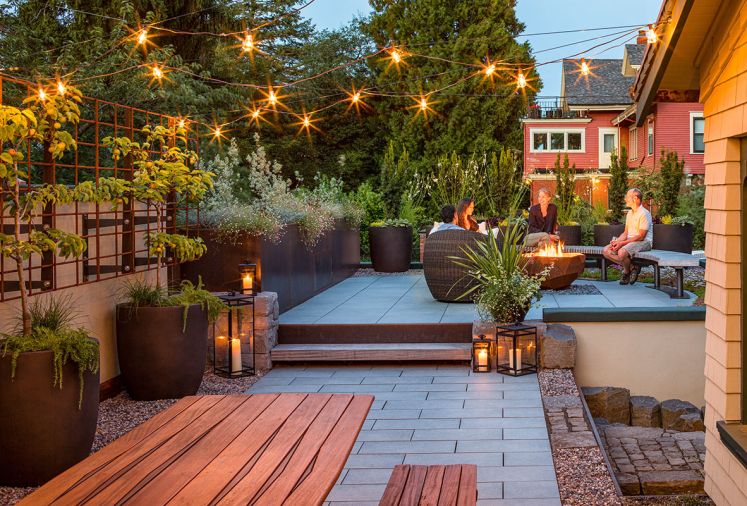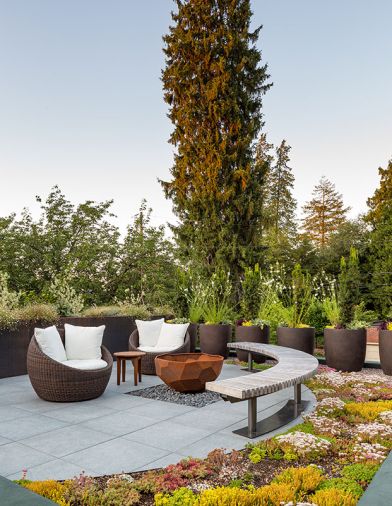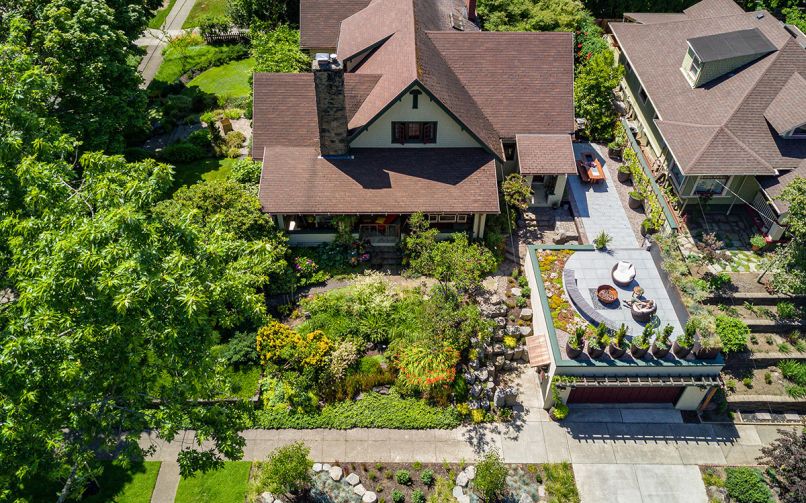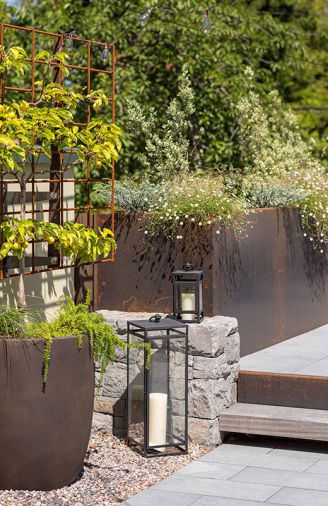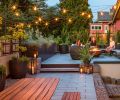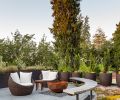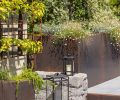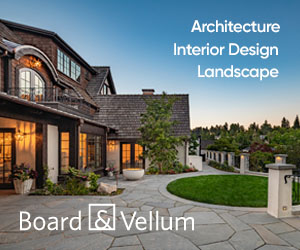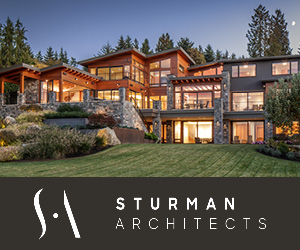When homeowner, Scott Colner, decided to replace his free-standing garage, he knew he wanted the replacement structure to take on multiple purposes. “The existing garage was an eyesore from both the street and the house,” said Colner. “It was crumbling from age and floated unconnected to the home and mature landscape.”
The structure was typical of small garage spaces in the historic neighborhood. Added 18 years after the home, it didn’t fall under the strict guidelines of the landmark registry, but it was necessary to meet more stringent code requirements.
The new studio garage was built to withstand the weight of potential outdoor living and garden. Colner had worked extensively on the property with Pete Wilson Stoneworks. He brought on landscape architect Rose Brady Keane to bring his vision to life.
“We wanted to respect the style of the existing home and garden, but not be afraid to do something different,” said Keane. “Using a deep sense of craft as the guide, we created a highly curated space where every element is thoughtful, will mature beautifully, and blends seamlessly to the existing environment.”
Off the kitchen, a terrace offers plein-air dining with a view to the higher rooftop lounge. Both utilize a pedestal paving system with porcelain tile. A lower, more casual, natural stone patio transitions to a columnar basalt boulder feature in the existing garden.
Privacy along the adjacent property line is achieved through a custom steel trellis feature fabricated by David Bertman Designs and large planters containing espaliered pears from Portland Nursery. Other edibles, including herbs and strawberries, flourish at the base of the planters.
“Because the garden was built on top of the owner’s new garage and studio, it was important that all built components be designed in such a way that they did not attach directly to the rooftop and that they that they could be disassembled and removed if necessary,” said Keane.
There are also limits to how much weight a rooftop garden can withstand. Planting and irrigation needs, soil composition, and the weight of the containers and built components were all factors to consider.
“The project had a lot of complexity,” said Wilson, “But it was expertly envisioned and executed by a dream collaboration between homeowner and craftspeople. I felt lucky to be a part of this group and creating this space. It’s very special.”
“This was a passion project for me,” Colner said. “It’s a welcoming space that gets a lot of use from family and friends. It was beautifully conceived and executed.”
PROJECT SOURCES
CONTRACTOR
Pete Wilson Stoneworks
petewilsonstoneworks.com
ARCHITECT
Donna Wax, Architect
LANDSCAPE ARCHITECTURE
Rose Brady Keane Landscape Architecture
rbkla.com
Shoptalk - Rose Brady Keane
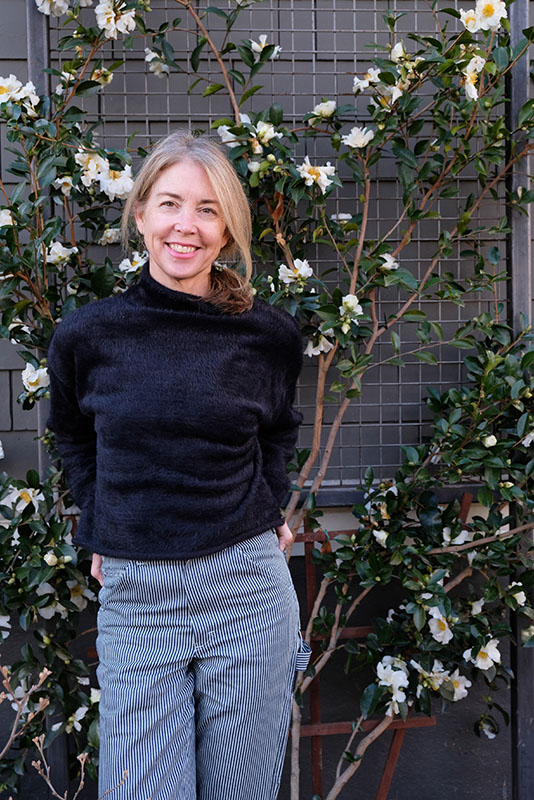
Rose Brady Keane, Owner, Rose Brady Keane Landscape Architecture
When you created your own firm, what were your goals? Was there something different that you wanted to do?
Early on I worked for multiple firms on public, private, urban, rural, large, and small projects. I enjoyed those years, and they were an important learning experience. I think I have always wanted to work for myself, but I wasn’t sure how that would take shape. Becoming my own boss seemed a necessary step to clarify my own values and goals relative to design and work in general. When we moved to Portland with small kids it seemed the logical step for me, it gave me the flexibility I needed and the ability to grow at my own pace.
Describe your design philosophy.
At times I have struggled with the perception that design is a luxury. Ultimately, I firmly believe that everyone can benefit from a well-designed space, and nature-even in a small urban garden-can offer restoration and connection. I think good design is thoughtful problem solving, careful observation and listening. There is inherent beauty and interest in so much of the world around us. Good landscape architecture can harness and enhance that and add something new, delightful & unexpected.
Can you trace your interest in landscape architecture and design back to a particular influence?
My mother is a landscape architect, so that way of thinking and looking at the world was always present. My childhood was imbued with a deep awareness and experience of natural and planned landscapes. I grew up on the San Francisco Bay and spent summers exploring family farms in southern Oregon and the central valley of California, the redwood forests on the northern California coast and the High Sierra. I come from a family with a history of cultivation, design and stewardship of the land that includes farmers, landscape architects, planners, environmentalists, gardeners, nurserymen, and good old-fashioned back-to-the-landers.
Favorite part of the design process?
There is a point after you assess a project: client needs, site opportunities and constraints, regulatory framework, site context, etc. and determine the project program that you sit down and let it all percolate and draw, think and struggle a bit until something clicks. I remember a T.A. in graduate school calling this “the design flash”, which at the time seemed sort of pretentious to me, but I think it’s really just the point at which you feel like the parts move into place and something intangible emerges that is simply how a space works and feels.
What are some of the current influences on your work?
I really seem to be gravitating toward the work of women artists, designers, writers and thinkers of all kinds these days…landscape architects like Christine Ten Eyck, sculptors, and painters, interior architects, editor and publisher of Wonderground Georgina Reid, even cartoonists, probably because of their ability to distill an idea with such economy.
What gardens inspire you?
Ancient gardens and agricultural landscapes-middle eastern/Islamic, Japanese, Chinese. The Alhambra, the gardens of Kyoto, Parisian storefronts and courtyards, traditional English gardens.
Best travel destination for inspiration?
Cities-San Francisco and Paris are places where I’ve spent a lot of time walking. Hiking or backpacking in the Cascade Range.
Three words that most appropriately sum up your approach to design are…
Collaboration, Intention, Delight.

